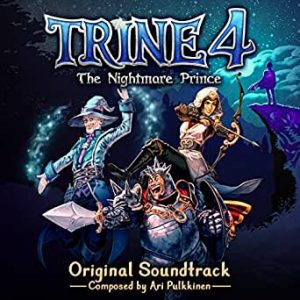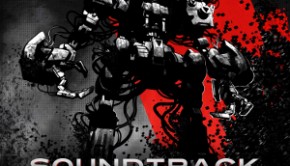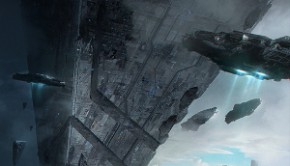Trine 4: The Nightmare Prince Original Soundtrack
 |
Album Title: Trine 4 Original Soundtrack |
| Record Label: N/A |
|
| Catalog No.: N/A |
|
| Release Date: October 08, 2019 |
|
| Purchase: Purchase on Amazon |
Overview
The four Trine games in the main series have been met with varying degrees of success; the first game’s whimsical animation and mechanics charmed players everywhere, and Trine 2 was able to double down on the first game’s success, adding a new layer of thoughtfulness and nuance to the story. Trine 4: The Nightmare Prince comes years after some of the rougher elements of the third game led to more critical reviews, and represents a welcome, and well-executed, return to the series’ “2.5 D” origins. Composer Ari Pulkkinen’s soundtracks to the series, meanwhile, have been consistently delightful, avoiding the dip in quality that many elements of Trine 3 suffered. How does the most recent, and possibly the last, soundtrack measure up?
Body
As with the previous soundtrack installments, Trine 4 opens with the game’s main theme, which initially seems to draw from other, similarly stylized games (think Ori), but quickly differentiates itself as the pace of the track picks up, and the instruments sink to lower, more ominous octaves. The game itself is certainly darker than its predecessors, and the music reflects that appropriately, particularly as a newer, more sinister melody takes over about a minute into the piece.
That’s not to say that the soundtrack is all darkness and angst – even the main theme ends with the triumphant Trine theme we first heard in Trine 2. Pulkkinen brings back a familiar tone with many of his tracks, while still successfully developing and executing new themes left and right. Additionally, there is a lot less reliance on ambient tracks on this album than on past Trine scores. As usual, most of the tracks represent an area theme, with a small handful belonging to various battles or cutscenes that take place in the game. “A Wintery Morning” sets the album off to an auspicious start – personally, this was the track on the score that transported me back to the world of Trine. While there are no repeated themes in the track, the bubbly clarinet, pizzicato strings, and soft harmonic interludes come together so warmly and innocently that it’s hard to think the track could belong to anything but a Trine score.
The lack of ambient tracks on the soundtrack seem to translate to Pulkkinen’s reaching into all corners of the orchestra for each of his tracks, which turns out beautifully. There’s no shortage of entrances made by new instruments, giving the entire soundtrack a lush feel. There are certainly returning players – pizzicato strings make their way onto nearly every track, and Pulkkinen has a penchant for alto winds that are very present across the album. But the tracks of Trine 4 manage to avoid repeating their instrument cast too often – “Craghill Moors” is much more string-oriented than its predecessors, featuring a whimsical cello solo front and center. The mystical “Heatherwood Hall” uses a hypnotizing vibraphone ostinato throughout most of the track that keeps the listener engaged across the various melody lines.
While a lot of tracks follow a similar pattern – a busy, magical background of strings, and some new instrument playing the melody in the foreground, the formula just works. Some of my favorite tracks on the score follow this pattern – “Moonlit Forests” brings a piano into the mix that plays a delightful series of scales during one of the most picturesque levels of the game, and the Shire-like level represented by “The Badgerbough” uses an alto clarinet for its melody that borders somewhere between eerie and humorous. “Goldleaf Garden” has a Celtic melody that helps it stand out from the rest of the score, and “The Gossamer Grove” dials back the animation for a slightly more subtle combination of piano, plucked strings, and voice. Regardless of their similarities and differences, none of these tracks lack the feeling of beauty that saturates the Trine games.
As mentioned earlier, Trine 4 does have a darker tone, and while many of the tracks continue the bright and bubbly tradition of earlier Trine games, other tracks would have no place in any installment but this one. “The Prince’s Dream” doubles as both an area theme and the main menu music, so players get a sense of the new mood in the game right from the start. However, “The Crackling Mire” was the first genuine surprise I had on the score – while it’s still very melodic, it’s easily the bleakest track I’ve heard in the series, and represents a significant tone shift in the soundtrack. That’s not to say I didn’t like it – on the contrary, the shockingly new sounds (heavy percussion, brash, brass accents) were refreshing. The tonal shift doesn’t end there – “Snow-Topped Heights”, one of the quieter tracks on the score, is saturated with a mix of wistfulness and heroism. Finally, “Haunted Tombs”, the last area theme in the game, brings the tone even darker. Along with a slightly rhythm, and a massive contrast between a low bassline and piano riffs in the higher octaves, the piece is decorated with a male chorus that first acts as a percussive element in the score and slowly increases in intensity as the loop progresses.
The bold shift in energy sets this soundtrack apart from its predecessors – these are brand new elements in the series, and they succeed in giving Trine 4 its own identity. On that note, the last few tracks I want to mention are the battle tracks, which are just a lot of fun – certainly they’re a lot more varied than in previous games. The battle themes are often variations of existing tracks in the game “A Knight Turned Villain” is a twist on “The Cursed Manor”; “A Wizard’s Worst Nightmare” takes “The Prince’s Dream” and dials it up in intensity. “The Rising Shadow”, the final track on the album, plays throughout the final boss fight, and ends the album on an appropriately dramatic note. There are a few very short battle themes throughout the game that I wish had made it on the soundtrack, but I’m content to settle for what we got.
Conclusion
Trine 4 exceeded the previous installments, and so did its soundtrack. The added moods rounded out the style successfully, adding some depth that was missing in the previous soundtracks, and making for a more complete listening experience from beginning to end. Additionally, almost every track makes a substantive contribution to the album as a whole – there isn’t much I could suggest as being filler content on the score. Each track brings its own set of themes and development to the table. As always, fans of animated medieval fantasy scores are in for a treat with Trine 4.
Do you agree with the review and score? Let us know in the comments below!
5
Posted on June 18, 2020 by Emily McMillan. Last modified on June 18, 2020.














